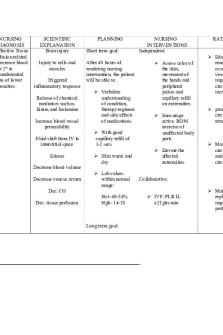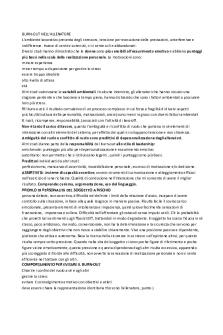Phases of Burn WA PDF

| Title | Phases of Burn WA |
|---|---|
| Course | Professional Nursing III |
| Institution | Rasmussen University |
| Pages | 3 |
| File Size | 112.2 KB |
| File Type | |
| Total Downloads | 30 |
| Total Views | 195 |
Summary
Written Assignment for Week 3 ...
Description
Phases of Burn Injury: Patient Care
Time Period:
Goals:
Nursing Dx:
Emergent 24-48/72 hours (Fluid loss up to 72 hrs)
Secure airway, support circulation, pain management, prevent infection, maintain temperature, provide emotional support (Sheridan, 2016)
Acute Pain R/T Destruction of skin tissue. Ineffective airway clearance R/T Trauma to upper airway by flame, steam, smoke Disturbed Body Image R/T Situational Crisis; disfigurement Impaired skin integrity R/T Disruption of skin surface with destruction of skin layers Risk for infection R/T Inadequate primary defenses; destruction of skin barrier (Vera, 2013)
Acute Rehab From end of emergent phase – From wound closure to patient to 7 days to months (depends on at highest level of functioning wounds- covered by skin grafts or healed) Reestablish independence, Pain management Family and patient support Treatment of burn wound groups Avoidance/detection/treatment of complications (most common: Psychosocial adjustment Prevention of infection, septicemia, pneumonia, renal disease, heart scars/contractures Resumption of pre-burn failure activities (Sheridan, 2016) (Sheridan, 2016) Disturbed body image Ineffective Tissue R/T Situational Crisis; Perfusion R/T reduction of atrial blood flow disfigurement Imbalanced nutrition R/T Anxiety R/T memory restricted oral intake of trauma experience Deficient fluid volume Chronic pain R/T nerve R/T loss of fluids through damage and poor burn wounds wound healing Impaired physical Risk for impaired skin mobility R/T integrity R/T Neuromuscular Disruption of skin impairment surface with (Vera, 2013) destruction of skin layers (Vera, 2013)
Assessment:
Shock from pain/hypovolemia Blisters, Adynamic ileus, (hypomotility of GI tract), Shivering, Altered mental status, Assess for inhalation injury, peripheral pulses, Rule of 9’s to assess % of TBSA damaged (Henderson, 2015)
Reaction to pain and pain level, wound assessment, head-to-toe assessment ever 8 hours, mental status, v/s, breath sounds, bowel sounds, dietary intake, motor ability, i/o, weight pattern, circulatory/grafts/donor site Assessment, COCA of wounds, Lab tests ; CBC (WBCs, Hmg, Hct), CMP: (electrolytes, liver function, kidney function), Nutritional status: body weight, serum albumin/pre-albumin levels, transferrin, urine urea nitrogen. CXR/ bronchoscopy for inhalation injuries (Henderson, 2015)
Continuous assessment Assess response to positioning, splinting, exercise, ability to perform daily wound care (post discharge), Assess for adequate circulation, cyanosis, temperature, adequate pulses Assess patient tolerance for exercise/ADLs, ambulation (Henderson, 2015)
References Matt Vera, RN (July 14, 2013). 11 Burn Injury Nursing Care Plans. Retrieved from https://nurseslabs.com/11-burn-injury-nursing-care-plans/4/
Roger Henderson, MD (July 24, 2015). Burns Assessment and Management. Retrieved from https://patient.info/doctor/burns-assessment-andmanagement Roger Sheridan, MD (September 22, 2016). Medscape; Burn Rehabilitation. Retrieved from http://emedicine.medscape.com/article/318436overview#a2...
Similar Free PDFs

Phases of Burn WA
- 3 Pages

Phases of Burn Injury
- 6 Pages

Gizmo Phases of Water Key
- 4 Pages

Worksheet 17 - Phases of Mitosis
- 8 Pages

Phases 234 - prac1
- 16 Pages

wad wa dwad wa a wa dadwa da
- 4 Pages

Lunar Phases
- 6 Pages

STA-201 WA # 4 - WA#4
- 2 Pages

LT The Cause of Moon Phases
- 3 Pages

2003 64772 NCP BURN docx
- 7 Pages
Popular Institutions
- Tinajero National High School - Annex
- Politeknik Caltex Riau
- Yokohama City University
- SGT University
- University of Al-Qadisiyah
- Divine Word College of Vigan
- Techniek College Rotterdam
- Universidade de Santiago
- Universiti Teknologi MARA Cawangan Johor Kampus Pasir Gudang
- Poltekkes Kemenkes Yogyakarta
- Baguio City National High School
- Colegio san marcos
- preparatoria uno
- Centro de Bachillerato Tecnológico Industrial y de Servicios No. 107
- Dalian Maritime University
- Quang Trung Secondary School
- Colegio Tecnológico en Informática
- Corporación Regional de Educación Superior
- Grupo CEDVA
- Dar Al Uloom University
- Centro de Estudios Preuniversitarios de la Universidad Nacional de Ingeniería
- 上智大学
- Aakash International School, Nuna Majara
- San Felipe Neri Catholic School
- Kang Chiao International School - New Taipei City
- Misamis Occidental National High School
- Institución Educativa Escuela Normal Juan Ladrilleros
- Kolehiyo ng Pantukan
- Batanes State College
- Instituto Continental
- Sekolah Menengah Kejuruan Kesehatan Kaltara (Tarakan)
- Colegio de La Inmaculada Concepcion - Cebu





